

Compact Muon Solenoid
LHC, CERN
| CMS-PAS-EXO-19-001 | ||
| Search for long-lived particles using delayed jets and missing transverse momentum with proton-proton collisions at √s = 13 TeV | ||
| CMS Collaboration | ||
| March 2019 | ||
| Abstract: A search for long-lived particles decaying to delayed jets and missing transverse momentum is presented. The analysis is performed using a data set of 137 fb−1 of √s= 13 TeV proton-proton collisions recorded by the CMS experiment. Candidate signal events containing delayed jets are identified using the timing capabilities of the CMS Electromagnetic Calorimeter. The results of the search are consistent with the background prediction and are interpreted using a gauge-mediated supersymmetry breaking reference model. Masses up to 2500 and 2150 GeV are excluded for proper decay lengths of 1 m and 30 m respectively. | ||
|
Links:
CDS record (PDF) ;
CADI line (restricted) ;
These preliminary results are superseded in this paper, PLB 797 (2019) 134876. The superseded preliminary plots can be found here. |
||
| Figures & Tables | Summary | Additional Figures & Tables | References | CMS Publications |
|---|
| Figures | |

png pdf |
Figure 1:
(a) Feynman diagram for the gluino GMSB signal model and (b) diagram showing a characteristic event which would be expected to pass signal model selection with delayed energy deposition in the ECAL and HCAL but without tracks from a primary vertex. |

png pdf |
Figure 1-a:
Feynman diagram for the gluino GMSB signal model. |

png pdf |
Figure 1-b:
Diagram showing a characteristic event which would be expected to pass signal model selection with delayed energy deposition in the ECAL and HCAL but without tracks from a primary vertex. |
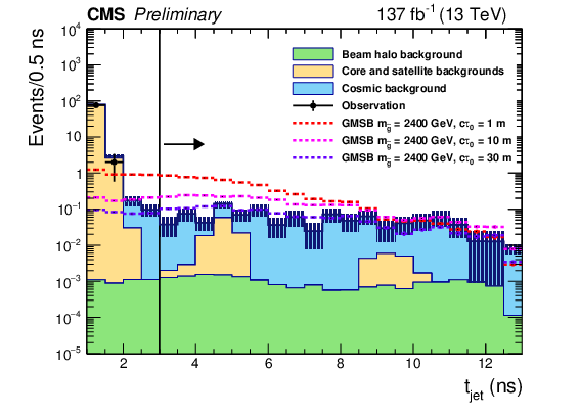
png pdf |
Figure 2:
The timing distribution of the backgrounds predicted to contribute to the signal region is compared to representative signal models. The templates for the major backgrounds are taken from control regions and normalised by the predictions detailed in Section xxxxx. No events are observed in data for tjet> 3 ns. |

png pdf |
Figure 3:
Efficiency in the mass and cτ0 plane for the GMSB model after all selections. |
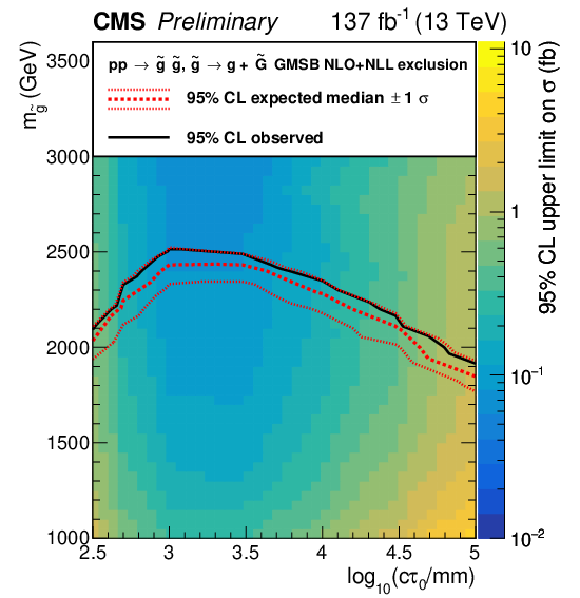
png pdf |
Figure 4:
The 95% CL observed upper limits on σ×BR2 in the mass and cτ0 plane for the GMSB model after all selections for 137 fb−1. The contour of 95% CL expected upper limits on σ/σtheory= 1 is shown in the solid line while the plus and minus one sigma variations are shown in the dashed lines. The observed limit is shown in the solid black line. |
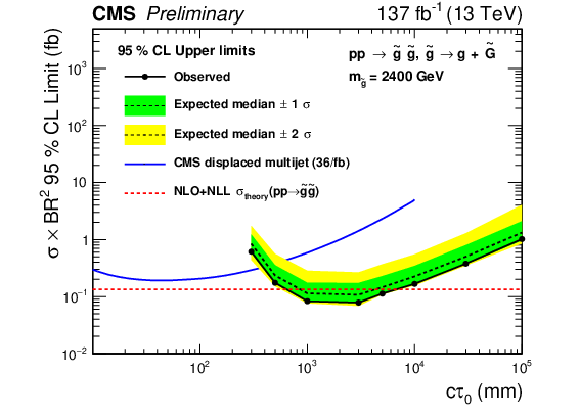
png pdf |
Figure 5:
Expected and observed limit on σ×BR2 after all signal region selections for a gluino GMSB model with m˜g= 2400 GeV are shown in the dotted and solid black lines respectively. The one (two) sigma variation in the expected limit is shown in green (yellow). The blue solid line shows the observed limit achieved by the CMS displaced jet search [43]. |
| Tables | |

png pdf |
Table 1:
Summary of the selections used to define the signal region. |

png pdf |
Table 2:
Background prediction summary. |

png pdf |
Table 3:
The derived variation on the acceptance on the modelling of the jet variables discussed in Section yyyyy for a representative model with m˜g= 2400 GeV. |
| Summary |
| An inclusive search for long-lived particles is reported, based on a data sample of pp collisions collected at √s= 13 TeV, corresponding to an integrated luminosity of 137 fb−1. The search uses timing of electromagnetic energy deposits to select delayed jets from the decays from heavy long-lived particles, with residual backgrounds estimated using measurements in control regions of the data. The results are interpreted using the gluino GMSB signal model, and gluino masses below 2100 GeV are excluded for decay lengths of ctau between 0.3 and 30 m. The reach is significantly extended in comparison to tracker based searches at CMS and ATLAS for tcellau>∼ 1 m [44,43,16]. |
| Additional Figures | |

png pdf |
Additional Figure 1:
The distribution of number of ECAL cells hit in the jet for jets in a background enriched data sample (satisfying |η|< 1.48, PVfractiontrack> 1/12, HEF> 0.2, tjet<−3 ns and ECSCECAL/EECAL< 0.8) and for signal jets satisfying signal region requirements (except those on EECAL and NcellECAL). |

png pdf |
Additional Figure 1-a:
The distribution of number of ECAL cells hit in the jet for jets in a background enriched data sample (satisfying |η|< 1.48, PVfractiontrack> 1/12, HEF> 0.2, tjet<−3 ns and ECSCECAL/EECAL< 0.8) and for signal jets satisfying signal region requirements (except those on EECAL and NcellECAL). |
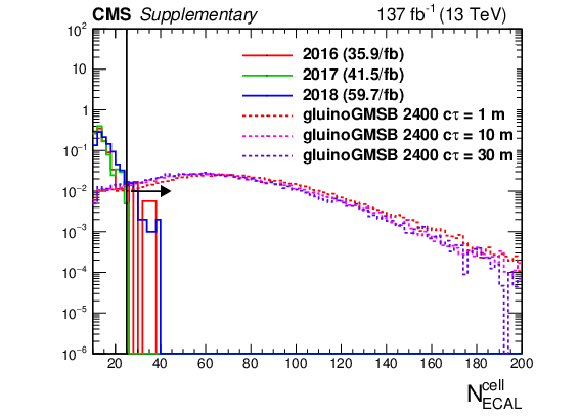
png pdf |
Additional Figure 1-b:
The distribution of number of ECAL cells hit in the jet for jets in a background enriched data sample (satisfying |η|< 1.48, PVfractiontrack> 1/12, HEF> 0.2, tjet<−3 ns and ECSCECAL/EECAL< 0.8) and for signal jets satisfying signal region requirements (except those on EECAL and NcellECAL). |

png pdf |
Additional Figure 1-c:
The distribution of number of ECAL cells hit in the jet for jets in a background enriched data sample (satisfying |η|< 1.48, PVfractiontrack> 1/12, HEF> 0.2, tjet<−3 ns and ECSCECAL/EECAL< 0.8) and for signal jets satisfying signal region requirements (except those on EECAL and NcellECAL). |

png pdf |
Additional Figure 2:
The distribution of HEF for a data sample enriched in beam halo and noise jets (satisfying |η|< 1.48, pT> 30 GeV, PVfractiontrack< 1/12, tjet<−3 ns, EECAL> 20 GeV and tRMSjet/tjet< 0.4) and for signal jets passing signal region selections (except on HEF). |
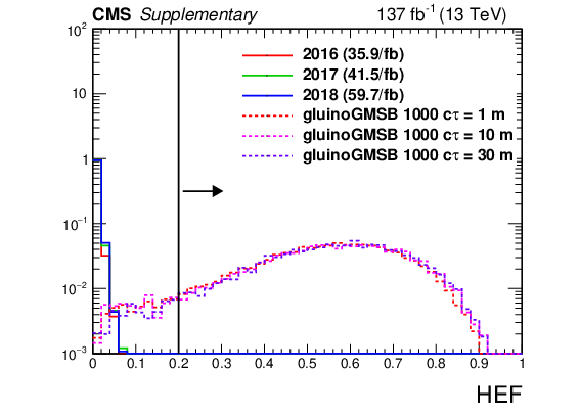
png pdf |
Additional Figure 2-a:
The distribution of HEF for a data sample enriched in beam halo and noise jets (satisfying |η|< 1.48, pT> 30 GeV, PVfractiontrack< 1/12, tjet<−3 ns, EECAL> 20 GeV and tRMSjet/tjet< 0.4) and for signal jets passing signal region selections (except on HEF). |
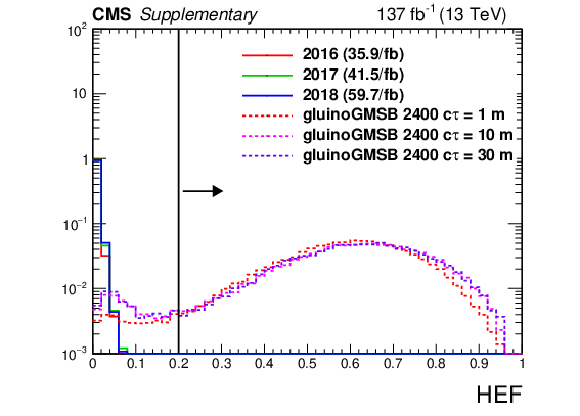
png pdf |
Additional Figure 2-b:
The distribution of HEF for a data sample enriched in beam halo and noise jets (satisfying |η|< 1.48, pT> 30 GeV, PVfractiontrack< 1/12, tjet<−3 ns, EECAL> 20 GeV and tRMSjet/tjet< 0.4) and for signal jets passing signal region selections (except on HEF). |
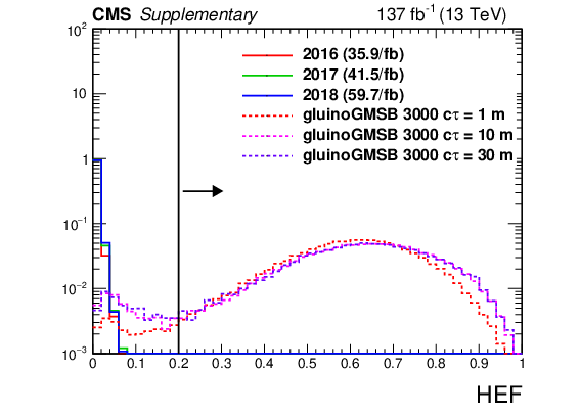
png pdf |
Additional Figure 2-c:
The distribution of HEF for a data sample enriched in beam halo and noise jets (satisfying |η|< 1.48, pT> 30 GeV, PVfractiontrack< 1/12, tjet<−3 ns, EECAL> 20 GeV and tRMSjet/tjet< 0.4) and for signal jets passing signal region selections (except on HEF). |

png pdf |
Additional Figure 3:
The distribution of EHCAL for a data sample enriched in beam halo and noise jets (satisfying |η|< 1.48, pT> 30 GeV, PVfractiontrack< 1/12, tjet<−3 ns, EECAL> 20 GeV and tRMSjet/tjet< 0.4) and for signal jets passing signal region selections (except on EHCAL). |
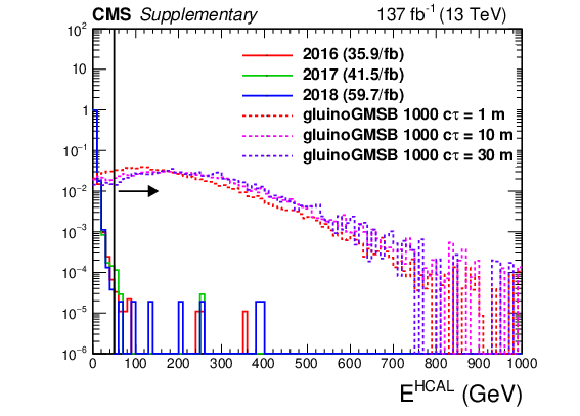
png pdf |
Additional Figure 3-a:
The distribution of EHCAL for a data sample enriched in beam halo and noise jets (satisfying |η|< 1.48, pT> 30 GeV, PVfractiontrack< 1/12, tjet<−3 ns, EECAL> 20 GeV and tRMSjet/tjet< 0.4) and for signal jets passing signal region selections (except on EHCAL). |
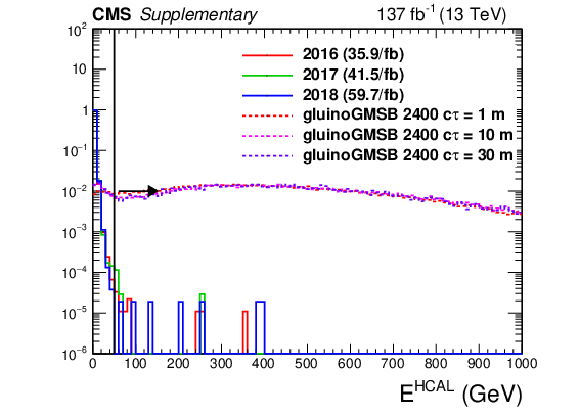
png pdf |
Additional Figure 3-b:
The distribution of EHCAL for a data sample enriched in beam halo and noise jets (satisfying |η|< 1.48, pT> 30 GeV, PVfractiontrack< 1/12, tjet<−3 ns, EECAL> 20 GeV and tRMSjet/tjet< 0.4) and for signal jets passing signal region selections (except on EHCAL). |
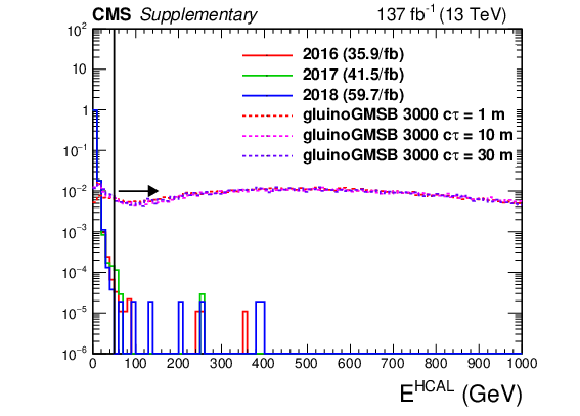
png pdf |
Additional Figure 3-c:
The distribution of EHCAL for a data sample enriched in beam halo and noise jets (satisfying |η|< 1.48, pT> 30 GeV, PVfractiontrack< 1/12, tjet<−3 ns, EECAL> 20 GeV and tRMSjet/tjet< 0.4) and for signal jets passing signal region selections (except on EHCAL). |
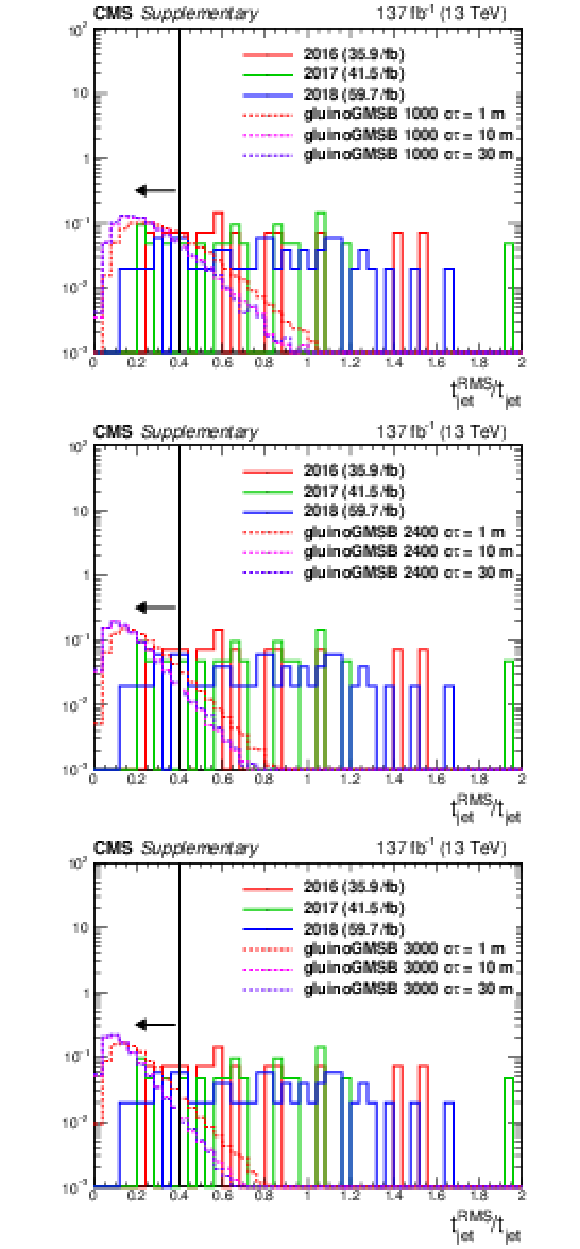
png pdf |
Additional Figure 4:
The distribution of tRMSjet/tjet for data sample enriched in jets from noise (satisfying |η|< 1.48, pT> 30 GeV, PVfractiontrack> 1/12, HEF> 0.2, tjet<−3 ns, EECAL> 20 GeV and ECSCECAL/EECAL< 0.8) and for signal jets passing signal region selections (except on tRMSjet/tjet and tRMSjet). |
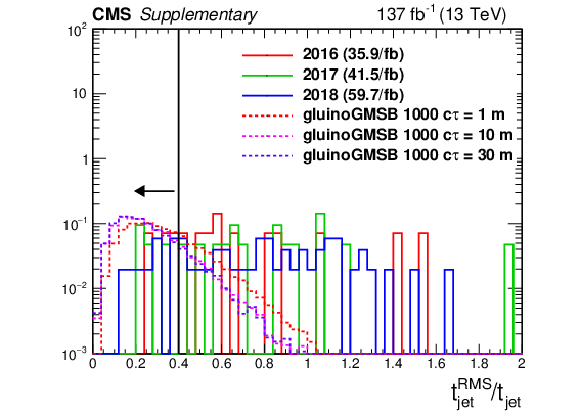
png pdf |
Additional Figure 4-a:
The distribution of tRMSjet/tjet for data sample enriched in jets from noise (satisfying |η|< 1.48, pT> 30 GeV, PVfractiontrack> 1/12, HEF> 0.2, tjet<−3 ns, EECAL> 20 GeV and ECSCECAL/EECAL< 0.8) and for signal jets passing signal region selections (except on tRMSjet/tjet and tRMSjet). |

png pdf |
Additional Figure 4-b:
The distribution of tRMSjet/tjet for data sample enriched in jets from noise (satisfying |η|< 1.48, pT> 30 GeV, PVfractiontrack> 1/12, HEF> 0.2, tjet<−3 ns, EECAL> 20 GeV and ECSCECAL/EECAL< 0.8) and for signal jets passing signal region selections (except on tRMSjet/tjet and tRMSjet). |

png pdf |
Additional Figure 4-c:
The distribution of tRMSjet/tjet for data sample enriched in jets from noise (satisfying |η|< 1.48, pT> 30 GeV, PVfractiontrack> 1/12, HEF> 0.2, tjet<−3 ns, EECAL> 20 GeV and ECSCECAL/EECAL< 0.8) and for signal jets passing signal region selections (except on tRMSjet/tjet and tRMSjet). |

png pdf |
Additional Figure 5:
The distribution of tRMSjet for data sample enriched in jets from noise (satisfying |η|< 1.48, pT> 30 GeV, PVfractiontrack> 1/12, HEF> 0.2, tjet<−3 ns, EECAL> 20 GeV and ECSCECAL/EECAL< 0.8) and for signal jets passing signal region selections (except on tRMSjet/tjet and tRMSjet). |

png pdf |
Additional Figure 5-a:
The distribution of tRMSjet for data sample enriched in jets from noise (satisfying |η|< 1.48, pT> 30 GeV, PVfractiontrack> 1/12, HEF> 0.2, tjet<−3 ns, EECAL> 20 GeV and ECSCECAL/EECAL< 0.8) and for signal jets passing signal region selections (except on tRMSjet/tjet and tRMSjet). |
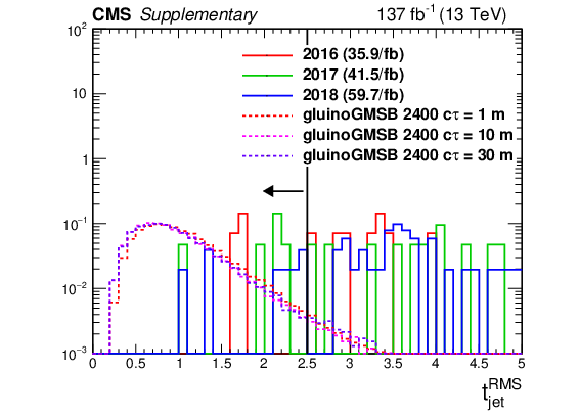
png pdf |
Additional Figure 5-b:
The distribution of tRMSjet for data sample enriched in jets from noise (satisfying |η|< 1.48, pT> 30 GeV, PVfractiontrack> 1/12, HEF> 0.2, tjet<−3 ns, EECAL> 20 GeV and ECSCECAL/EECAL< 0.8) and for signal jets passing signal region selections (except on tRMSjet/tjet and tRMSjet). |
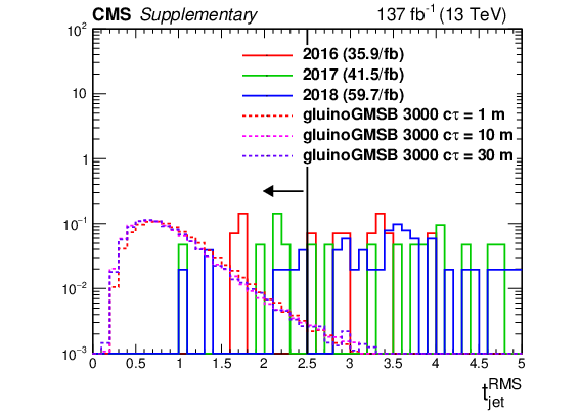
png pdf |
Additional Figure 5-c:
The distribution of tRMSjet for data sample enriched in jets from noise (satisfying |η|< 1.48, pT> 30 GeV, PVfractiontrack> 1/12, HEF> 0.2, tjet<−3 ns, EECAL> 20 GeV and ECSCECAL/EECAL< 0.8) and for signal jets passing signal region selections (except on tRMSjet/tjet and tRMSjet). |
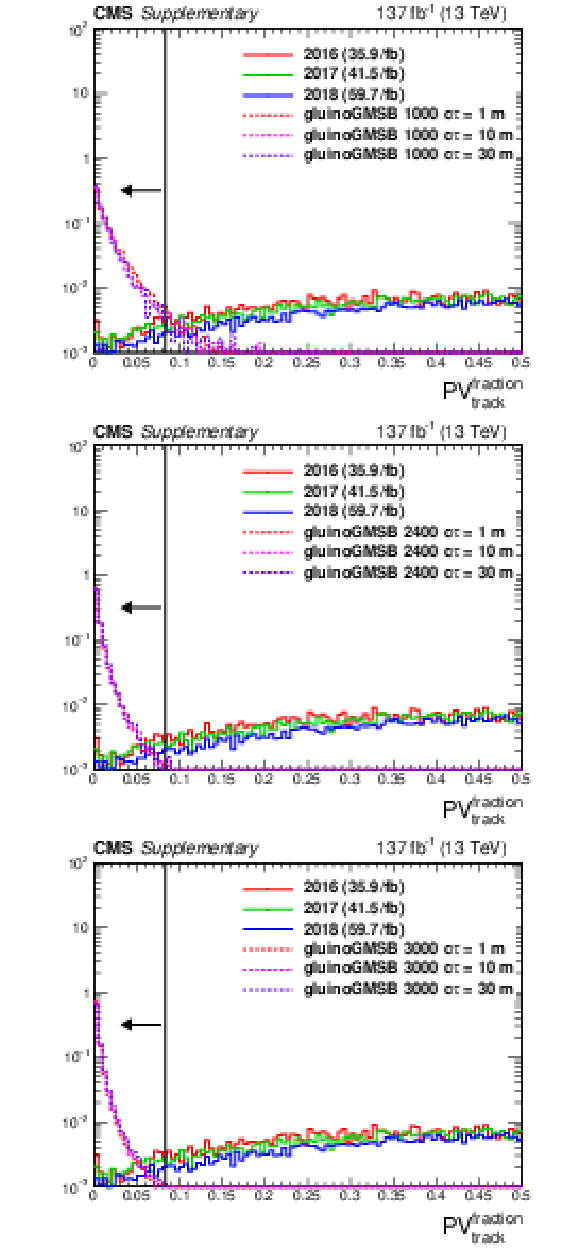
png pdf |
Additional Figure 6:
The distribution of PVfractiontrack for a data sample enriched in core backgrounds (satisfying pT> 30 GeV, |η|< 1.48, ECSCECAL/EECAL< 0.8, |tjet|< 3 ns and EECAL> 20 GeV) and for signal jets passing signal selections (except on PVfractiontrack). |

png pdf |
Additional Figure 6-a:
The distribution of PVfractiontrack for a data sample enriched in core backgrounds (satisfying pT> 30 GeV, |η|< 1.48, ECSCECAL/EECAL< 0.8, |tjet|< 3 ns and EECAL> 20 GeV) and for signal jets passing signal selections (except on PVfractiontrack). |
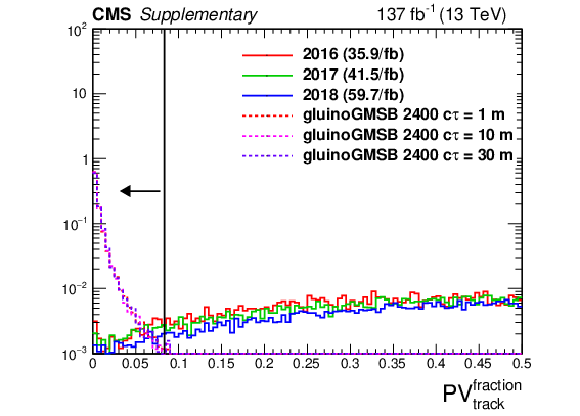
png pdf |
Additional Figure 6-b:
The distribution of PVfractiontrack for a data sample enriched in core backgrounds (satisfying pT> 30 GeV, |η|< 1.48, ECSCECAL/EECAL< 0.8, |tjet|< 3 ns and EECAL> 20 GeV) and for signal jets passing signal selections (except on PVfractiontrack). |

png pdf |
Additional Figure 6-c:
The distribution of PVfractiontrack for a data sample enriched in core backgrounds (satisfying pT> 30 GeV, |η|< 1.48, ECSCECAL/EECAL< 0.8, |tjet|< 3 ns and EECAL> 20 GeV) and for signal jets passing signal selections (except on PVfractiontrack). |
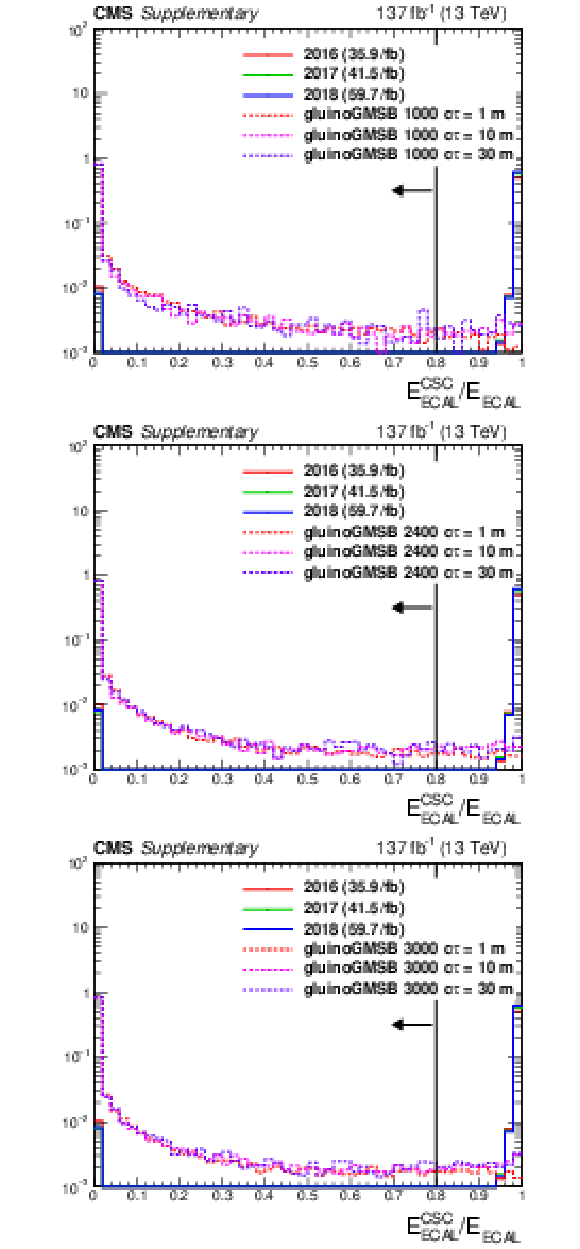
png pdf |
Additional Figure 7:
The distribution of ECSCECAL/EECAL for a data sample enriched in beam halo (satisfying pT> 30 GeV, |η|< 1.48, PVfractiontrack< 1/12, HEF< 0.2, tRMSjet/tjet< 0.4, tjet<−3 ns and EECAL> 20 GeV) and for signal jets passing signal selections (except on ECSCECAL/EECAL). |
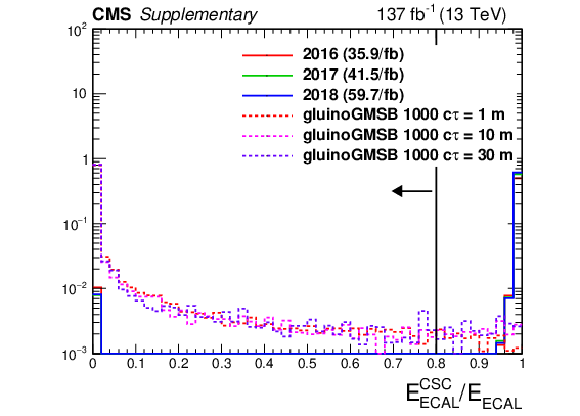
png pdf |
Additional Figure 7-a:
The distribution of ECSCECAL/EECAL for a data sample enriched in beam halo (satisfying pT> 30 GeV, |η|< 1.48, PVfractiontrack< 1/12, HEF< 0.2, tRMSjet/tjet< 0.4, tjet<−3 ns and EECAL> 20 GeV) and for signal jets passing signal selections (except on ECSCECAL/EECAL). |
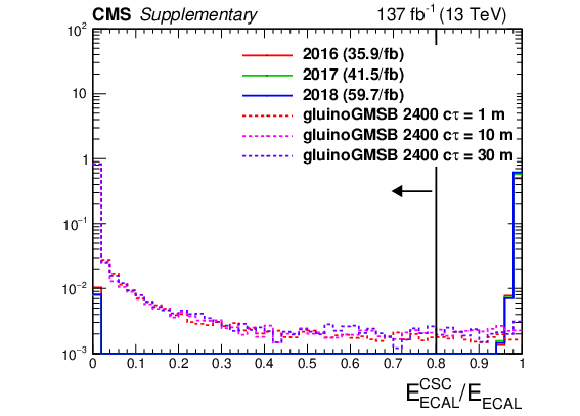
png pdf |
Additional Figure 7-b:
The distribution of ECSCECAL/EECAL for a data sample enriched in beam halo (satisfying pT> 30 GeV, |η|< 1.48, PVfractiontrack< 1/12, HEF< 0.2, tRMSjet/tjet< 0.4, tjet<−3 ns and EECAL> 20 GeV) and for signal jets passing signal selections (except on ECSCECAL/EECAL). |

png pdf |
Additional Figure 7-c:
The distribution of ECSCECAL/EECAL for a data sample enriched in beam halo (satisfying pT> 30 GeV, |η|< 1.48, PVfractiontrack< 1/12, HEF< 0.2, tRMSjet/tjet< 0.4, tjet<−3 ns and EECAL> 20 GeV) and for signal jets passing signal selections (except on ECSCECAL/EECAL). |

png pdf |
Additional Figure 8:
The distribution of max(ΔϕDTpaired) for a data sample enriched in cosmic muons (satisfying ECSCECAL/EECAL< 0.8, pT> 30 GeV, |η|< 1.48, PVfractiontrack< 1/12, HEF> 0.2, tRMSjet/tjet< 0.4, tjet> 3 ns, EECAL> 20 GeV and failing the HCAL noise rejection quality filters) and for signal jets passing signal selections (except on max(ΔϕDTpaired)). |

png pdf |
Additional Figure 8-a:
The distribution of max(ΔϕDTpaired) for a data sample enriched in cosmic muons (satisfying ECSCECAL/EECAL< 0.8, pT> 30 GeV, |η|< 1.48, PVfractiontrack< 1/12, HEF> 0.2, tRMSjet/tjet< 0.4, tjet> 3 ns, EECAL> 20 GeV and failing the HCAL noise rejection quality filters) and for signal jets passing signal selections (except on max(ΔϕDTpaired)). |

png pdf |
Additional Figure 8-b:
The distribution of max(ΔϕDTpaired) for a data sample enriched in cosmic muons (satisfying ECSCECAL/EECAL< 0.8, pT> 30 GeV, |η|< 1.48, PVfractiontrack< 1/12, HEF> 0.2, tRMSjet/tjet< 0.4, tjet> 3 ns, EECAL> 20 GeV and failing the HCAL noise rejection quality filters) and for signal jets passing signal selections (except on max(ΔϕDTpaired)). |
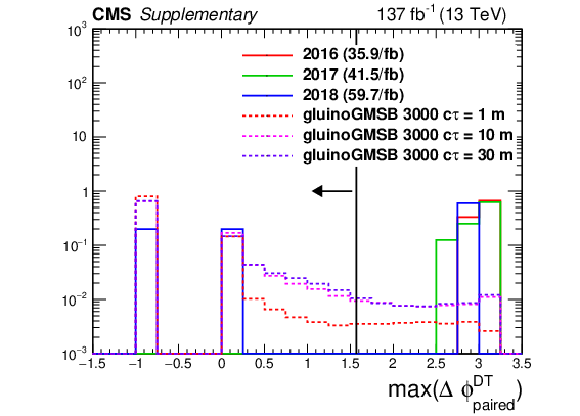
png pdf |
Additional Figure 8-c:
The distribution of max(ΔϕDTpaired) for a data sample enriched in cosmic muons (satisfying ECSCECAL/EECAL< 0.8, pT> 30 GeV, |η|< 1.48, PVfractiontrack< 1/12, HEF> 0.2, tRMSjet/tjet< 0.4, tjet> 3 ns, EECAL> 20 GeV and failing the HCAL noise rejection quality filters) and for signal jets passing signal selections (except on max(ΔϕDTpaired)). |

png pdf |
Additional Figure 9:
The distribution of max(ΔϕRPCpaired) for a data sample enriched in cosmic muons (satisfying ECSCECAL/EECAL< 0.8, pT> 30 GeV, |η|< 1.48, PVfractiontrack< 1/12, HEF> 0.2, tRMSjet/tjet< 0.4, tjet> 3 ns, EECAL> 20 GeV and failing the HCAL noise rejection quality filters) and for signal jets passing signal selections (except on max(ΔϕRPCpaired)). |
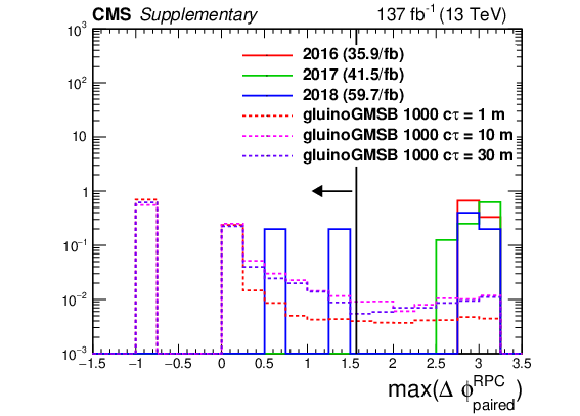
png pdf |
Additional Figure 9-a:
The distribution of max(ΔϕRPCpaired) for a data sample enriched in cosmic muons (satisfying ECSCECAL/EECAL< 0.8, pT> 30 GeV, |η|< 1.48, PVfractiontrack< 1/12, HEF> 0.2, tRMSjet/tjet< 0.4, tjet> 3 ns, EECAL> 20 GeV and failing the HCAL noise rejection quality filters) and for signal jets passing signal selections (except on max(ΔϕRPCpaired)). |
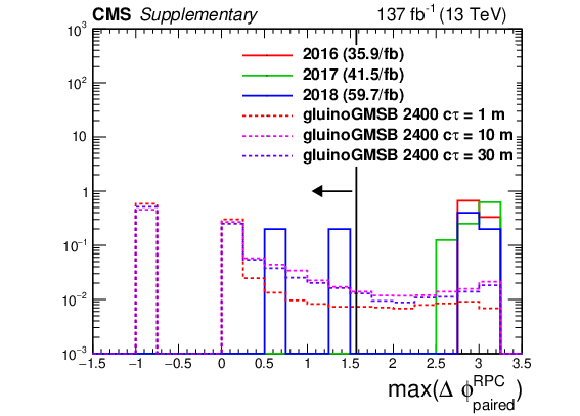
png pdf |
Additional Figure 9-b:
The distribution of max(ΔϕRPCpaired) for a data sample enriched in cosmic muons (satisfying ECSCECAL/EECAL< 0.8, pT> 30 GeV, |η|< 1.48, PVfractiontrack< 1/12, HEF> 0.2, tRMSjet/tjet< 0.4, tjet> 3 ns, EECAL> 20 GeV and failing the HCAL noise rejection quality filters) and for signal jets passing signal selections (except on max(ΔϕRPCpaired)). |
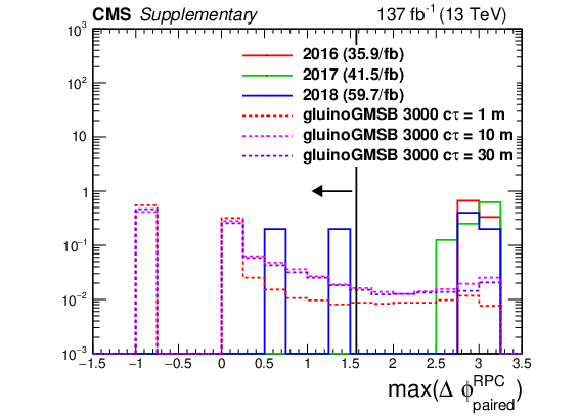
png pdf |
Additional Figure 9-c:
The distribution of max(ΔϕRPCpaired) for a data sample enriched in cosmic muons (satisfying ECSCECAL/EECAL< 0.8, pT> 30 GeV, |η|< 1.48, PVfractiontrack< 1/12, HEF> 0.2, tRMSjet/tjet< 0.4, tjet> 3 ns, EECAL> 20 GeV and failing the HCAL noise rejection quality filters) and for signal jets passing signal selections (except on max(ΔϕRPCpaired)). |
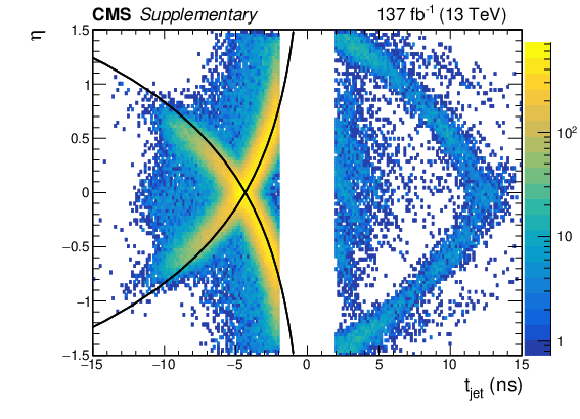
png pdf |
Additional Figure 10:
The η dependence of the jet time for jets passing beam halo selection and with |tjet|> 2 ns. The black lines show the expected time distribution from the path difference for beam halo from the main bunch. Additional deposits, including those aat positive times, come from beam halo associated with satellite and following or previous main bunches. |
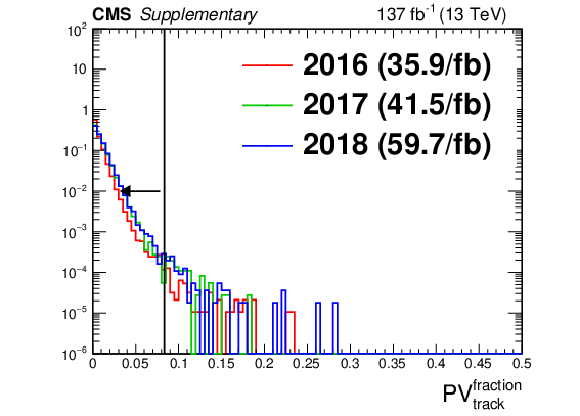
png pdf |
Additional Figure 11:
The distribution of PVfractiontrack for a data sample enriched in beam halo (satisfying pT> 30 GeV, |η|< 1.48, HEF< 0.2, tRMSjet/tjet< 0.4, jtrms< 2.5 and tjet<−3 ns). |

png pdf |
Additional Figure 12:
The distribution of tRMSjet for a data sample enriched in beam halo (satisfying pT> 30 GeV, |η|< 1.48, HEF< 0.2, PVfractiontrack< 1/12 and tjet<−3 ns). |
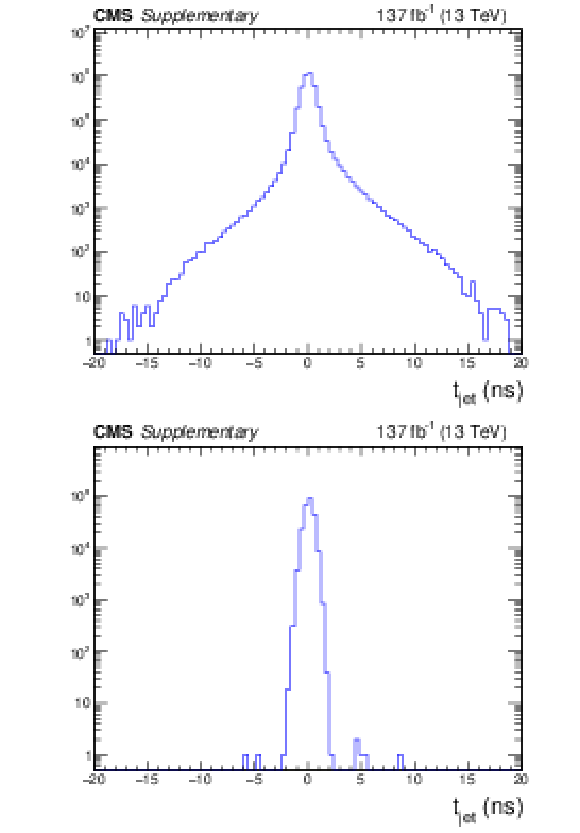
png pdf |
Additional Figure 13:
Distribution of tjet for jets with the full Run 2 dataset with no cleaning selection applied (a) and after all jet cleaning selections are applied (b) in events satisfying the trigger requirements and satisfying pTmiss> 300. The jets are required to pass an inverted selection of PVfractiontrack> 1/12 to enrich in jets from core backgrounds and satellite bunches. The cleaning selections are shown to reduce the backgrounds by many orders of magnitude. |

png pdf |
Additional Figure 13-a:
Distribution of tjet for jets with the full Run 2 dataset with no cleaning selection applied in events satisfying the trigger requirements and satisfying pTmiss> 300. The jets are required to pass an inverted selection of PVfractiontrack> 1/12 to enrich in jets from core backgrounds and satellite bunches. The cleaning selections are shown to reduce the backgrounds by many orders of magnitude. |

png pdf |
Additional Figure 13-b:
Distribution of tjet for jets with the full Run 2 dataset after all jet cleaning selections are applied in events satisfying the trigger requirements and satisfying pTmiss> 300. The jets are required to pass an inverted selection of PVfractiontrack> 1/12 to enrich in jets from core backgrounds and satellite bunches. The cleaning selections are shown to reduce the backgrounds by many orders of magnitude. |

png pdf |
Additional Figure 14:
Distribution of tjet for jets with the full Run 2 dataset in events satisfying the trigger requirements and satisfying pTmiss<300. An inverted selection of PVfractiontrack> 1/12 enriches in jets from core backgrounds and satellite bunches (all other jet cleaning selections are applied). Clear contributions from jets from satellite bunch collisions can be seen peaked around -5, 5 and 10 ns. |
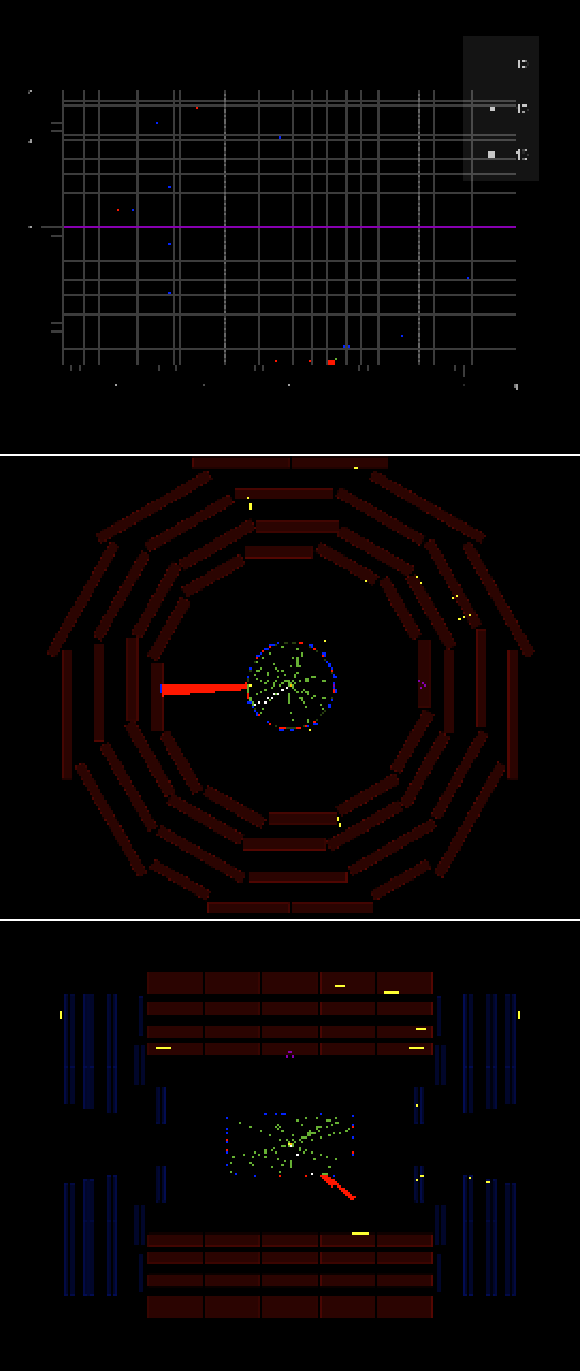
png pdf |
Additional Figure 15:
Event display for a beam muon candidate event which satisfies all signal selections except for HEF and ECSCECAL/EECAL (black background). |
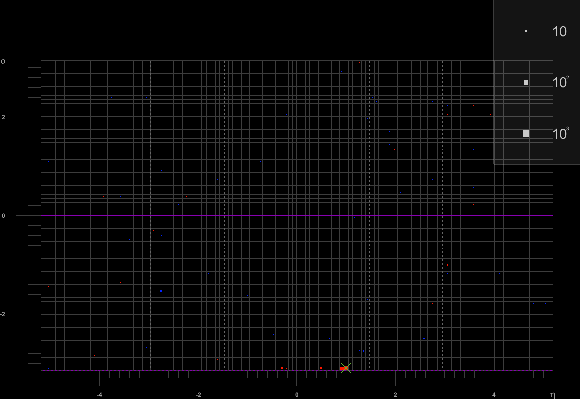
png pdf |
Additional Figure 15-a:
Event display for a beam muon candidate event which satisfies all signal selections except for HEF and ECSCECAL/EECAL (black background). |
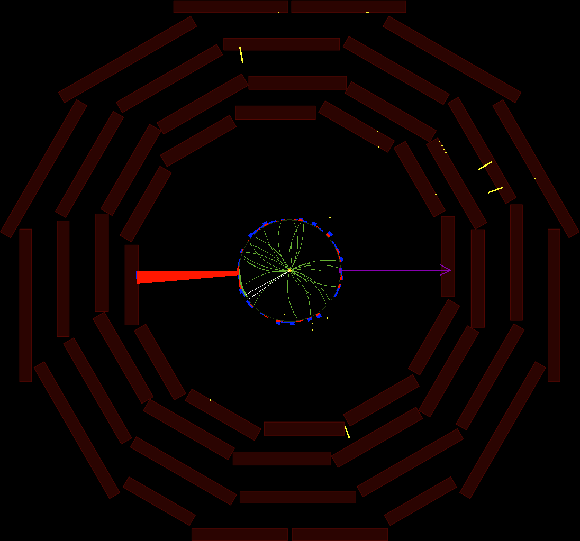
png pdf |
Additional Figure 15-b:
Event display for a beam muon candidate event which satisfies all signal selections except for HEF and ECSCECAL/EECAL (black background). |

png pdf |
Additional Figure 15-c:
Event display for a beam muon candidate event which satisfies all signal selections except for HEF and ECSCECAL/EECAL (black background). |

png pdf |
Additional Figure 16:
Event display for a beam muon candidate event which satisfies all signal selections except for HEF and ECSCECAL/EECAL (white background). |

png pdf |
Additional Figure 16-a:
Event display for a beam muon candidate event which satisfies all signal selections except for HEF and ECSCECAL/EECAL (white background). |
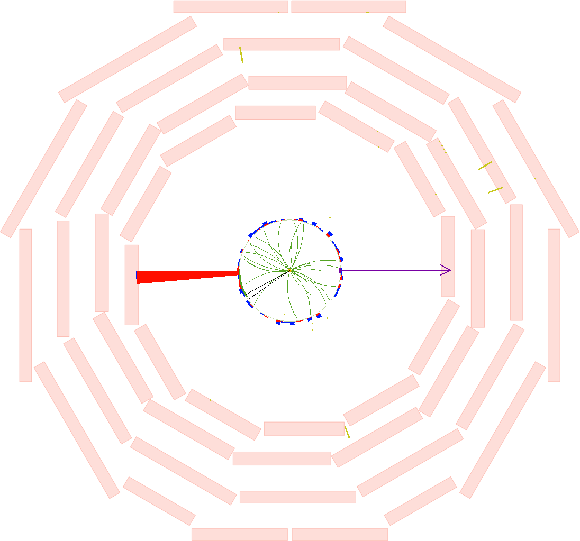
png pdf |
Additional Figure 16-b:
Event display for a beam muon candidate event which satisfies all signal selections except for HEF and ECSCECAL/EECAL (white background). |
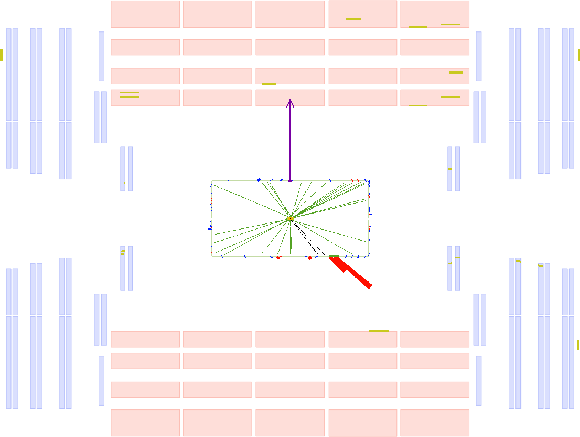
png pdf |
Additional Figure 16-c:
Event display for a beam muon candidate event which satisfies all signal selections except for HEF and ECSCECAL/EECAL (white background). |

png pdf |
Additional Figure 17:
Event display for a cosmic muon candidate which satisfies all signal selections except for max(ΔϕDTpaired) (black background). |
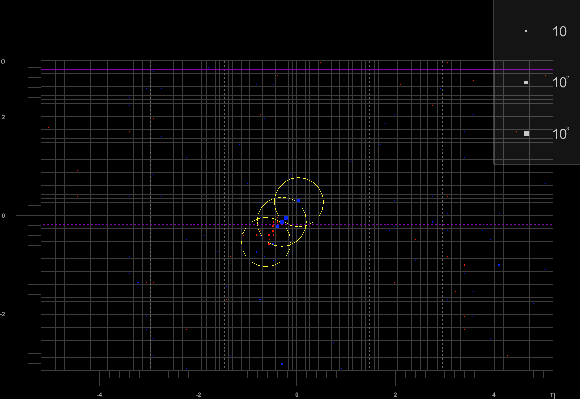
png pdf |
Additional Figure 17-a:
Event display for a cosmic muon candidate which satisfies all signal selections except for max(ΔϕDTpaired) (black background). |
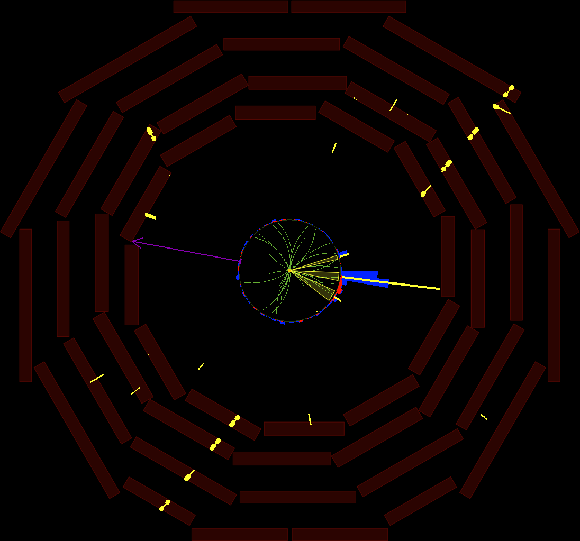
png pdf |
Additional Figure 17-b:
Event display for a cosmic muon candidate which satisfies all signal selections except for max(ΔϕDTpaired) (black background). |
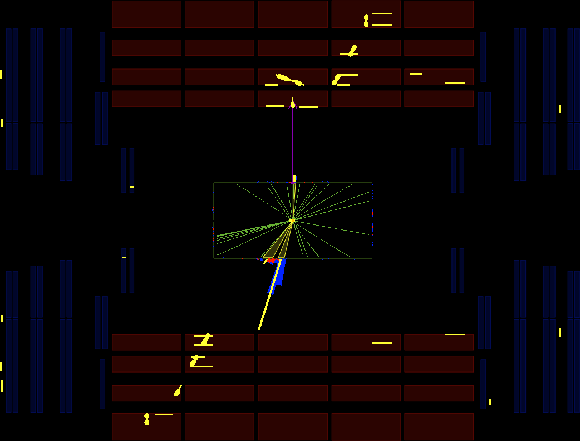
png pdf |
Additional Figure 17-c:
Event display for a cosmic muon candidate which satisfies all signal selections except for max(ΔϕDTpaired) (black background). |
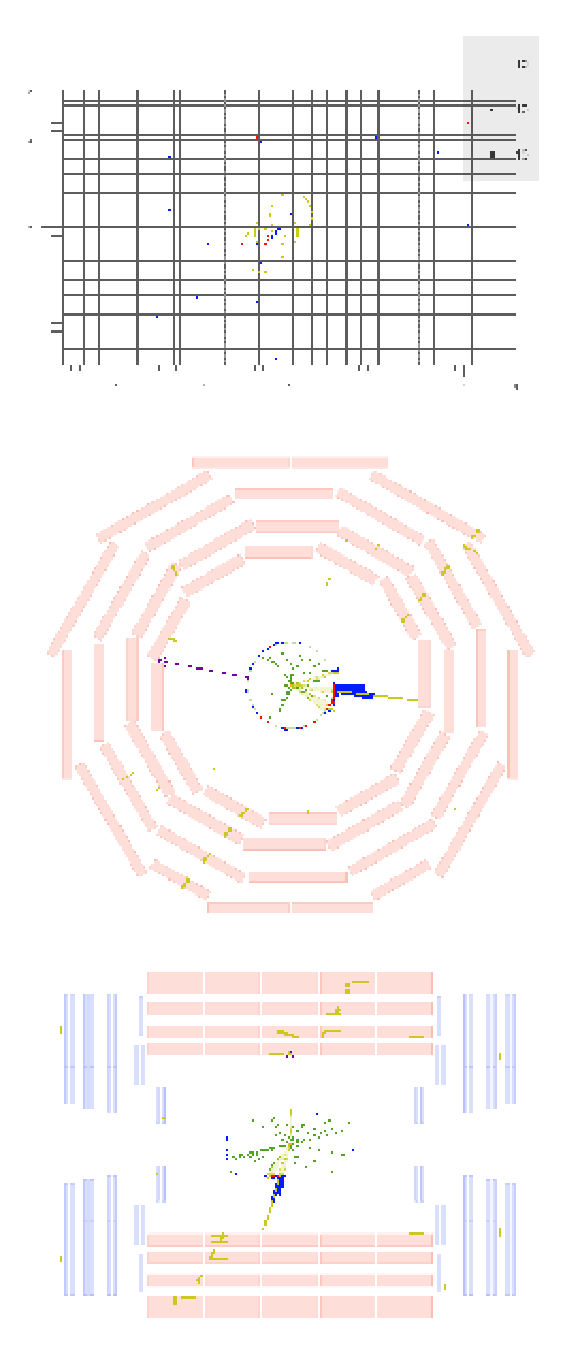
png pdf |
Additional Figure 18:
Event display for a cosmic muon candidate which satisfies all signal selections except for max(ΔϕDTpaired) (white background). |
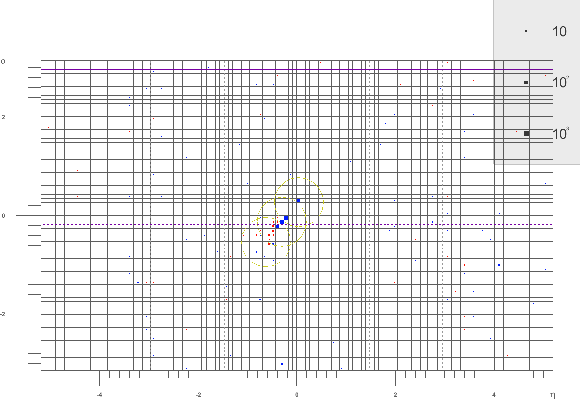
png pdf |
Additional Figure 18-a:
Event display for a cosmic muon candidate which satisfies all signal selections except for max(ΔϕDTpaired) (white background). |

png pdf |
Additional Figure 18-b:
Event display for a cosmic muon candidate which satisfies all signal selections except for max(ΔϕDTpaired) (white background). |

png pdf |
Additional Figure 18-c:
Event display for a cosmic muon candidate which satisfies all signal selections except for max(ΔϕDTpaired) (white background). |

png pdf |
Additional Figure 19:
Event display for a cosmic muon candidate which satisfies all signal selections except for max(ΔϕRPCpaired) (black background). |
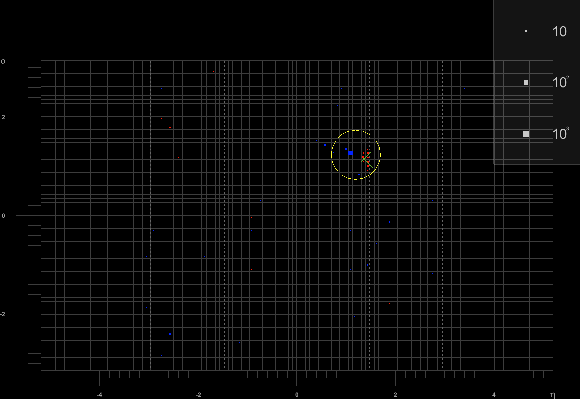
png pdf |
Additional Figure 19-a:
Event display for a cosmic muon candidate which satisfies all signal selections except for max(ΔϕRPCpaired) (black background). |
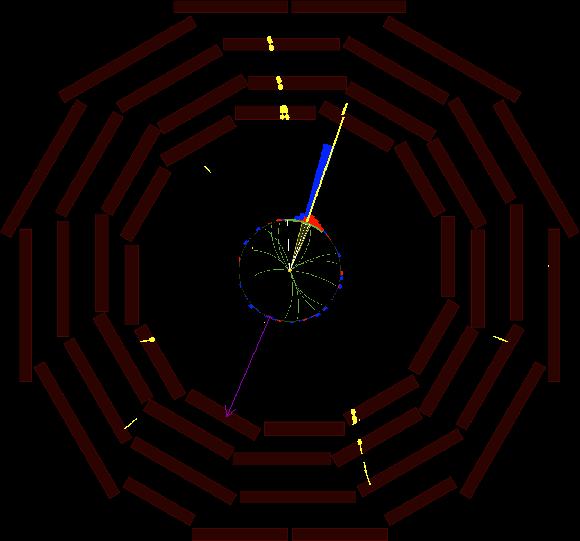
png pdf |
Additional Figure 19-b:
Event display for a cosmic muon candidate which satisfies all signal selections except for max(ΔϕRPCpaired) (black background). |
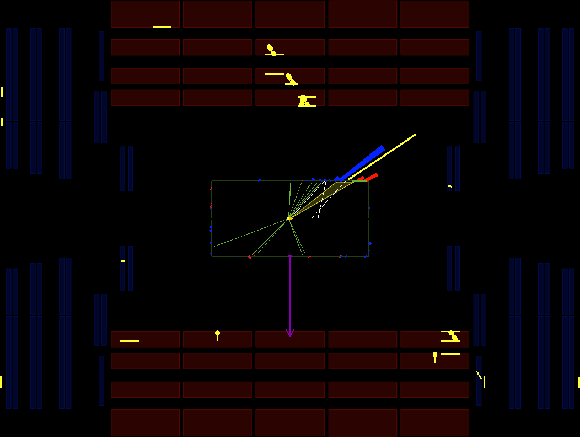
png pdf |
Additional Figure 19-c:
Event display for a cosmic muon candidate which satisfies all signal selections except for max(ΔϕRPCpaired) (black background). |

png pdf |
Additional Figure 20:
Event display for a cosmic muon candidate which satisfies all signal selections except for max(ΔϕRPCpaired) (white background). |

png pdf |
Additional Figure 20-a:
Event display for a cosmic muon candidate which satisfies all signal selections except for max(ΔϕRPCpaired) (white background). |
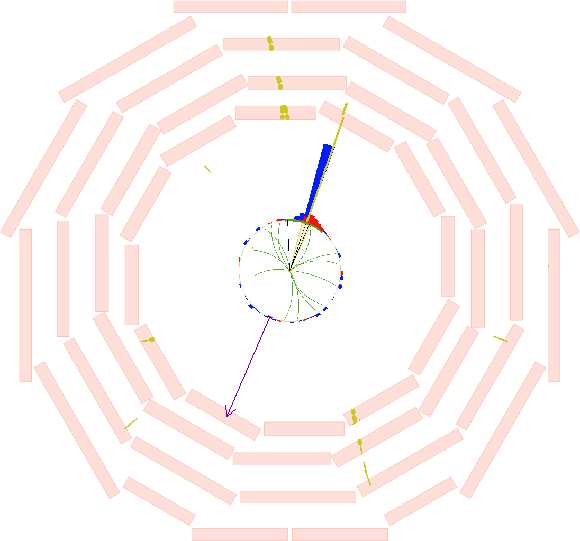
png pdf |
Additional Figure 20-b:
Event display for a cosmic muon candidate which satisfies all signal selections except for max(ΔϕRPCpaired) (white background). |

png pdf |
Additional Figure 20-c:
Event display for a cosmic muon candidate which satisfies all signal selections except for max(ΔϕRPCpaired) (white background). |

png pdf |
Additional Figure 21:
Event display for a satellite bunch candidate which satisfies all signal selections except for PVfractiontrack (black background). |
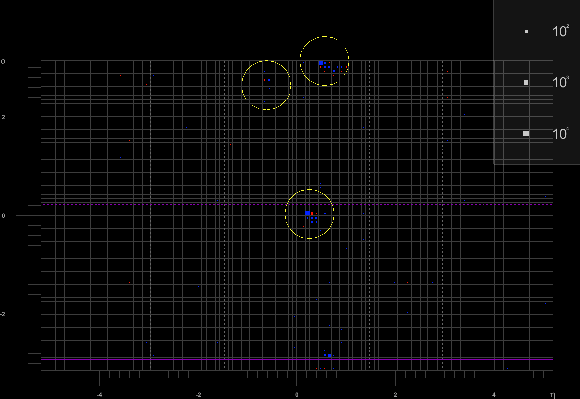
png pdf |
Additional Figure 21-a:
Event display for a satellite bunch candidate which satisfies all signal selections except for PVfractiontrack (black background). |

png pdf |
Additional Figure 21-b:
Event display for a satellite bunch candidate which satisfies all signal selections except for PVfractiontrack (black background). |
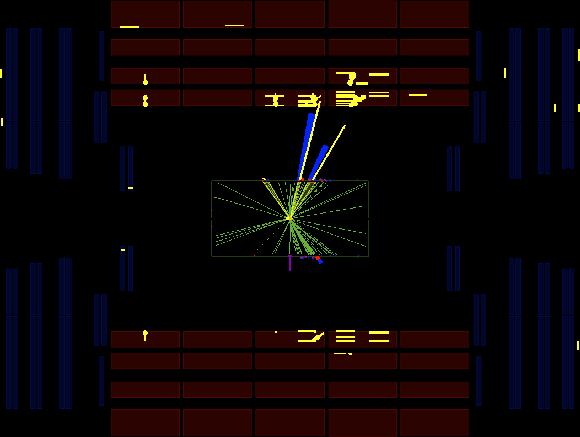
png pdf |
Additional Figure 21-c:
Event display for a satellite bunch candidate which satisfies all signal selections except for PVfractiontrack (black background). |
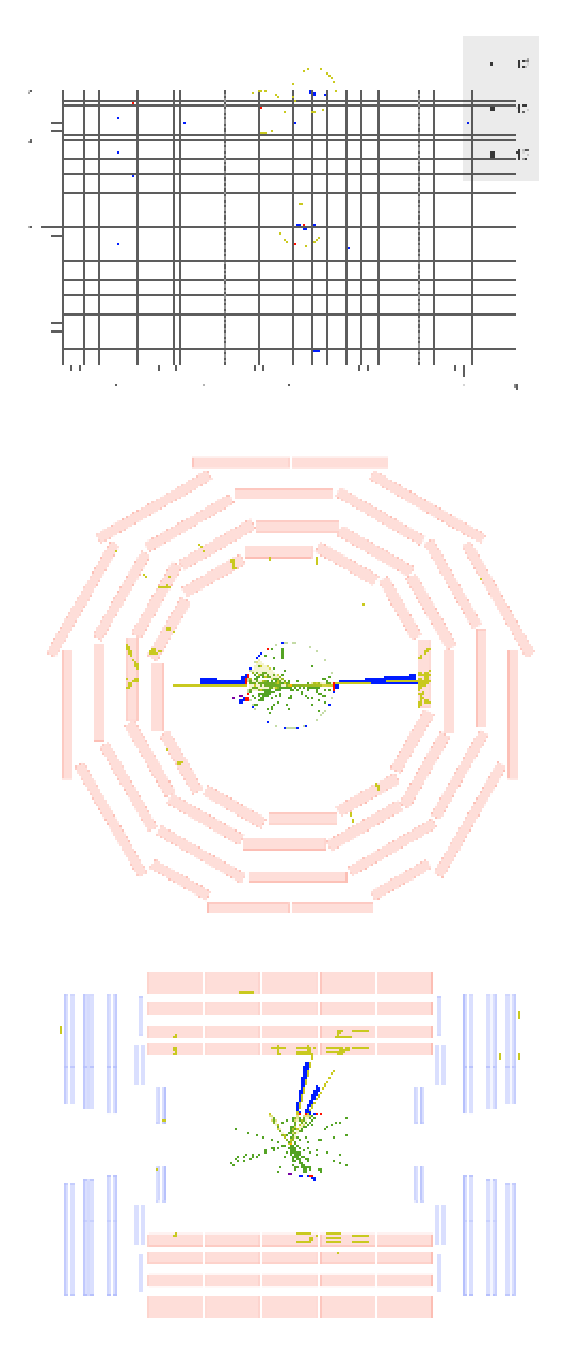
png pdf |
Additional Figure 22:
Event display for a satellite bunch candidate which satisfies all signal selections except for PVfractiontrack (white background). |
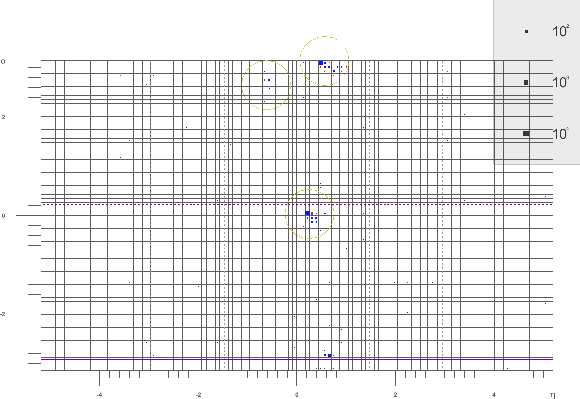
png pdf |
Additional Figure 22-a:
Event display for a satellite bunch candidate which satisfies all signal selections except for PVfractiontrack (white background). |

png pdf |
Additional Figure 22-b:
Event display for a satellite bunch candidate which satisfies all signal selections except for PVfractiontrack (white background). |
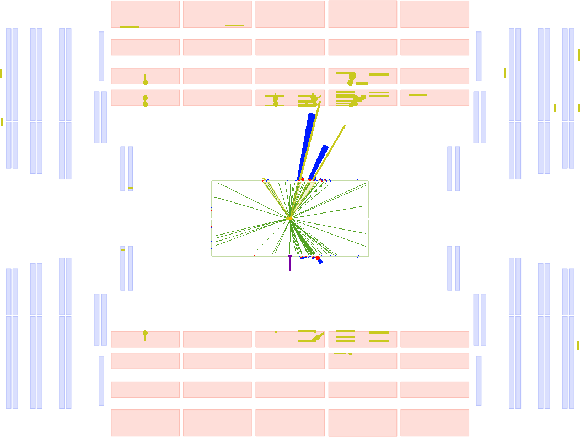
png pdf |
Additional Figure 22-c:
Event display for a satellite bunch candidate which satisfies all signal selections except for PVfractiontrack (white background). |
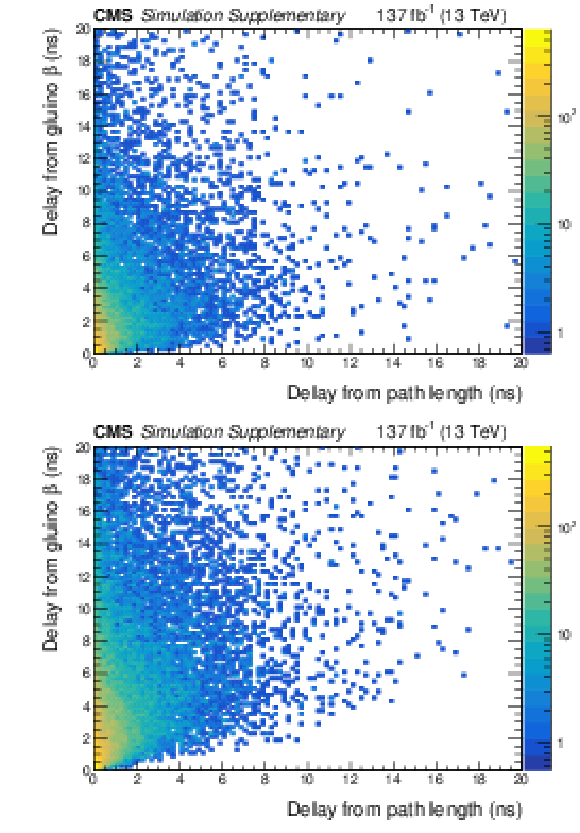
png pdf |
Additional Figure 23:
Jet delay contribution from the β of the gluino is plotted against the delay contribution from the difference (assuming straight line paths) between the path taken by the gluino and the particle forming the jet from the path length for a particle travelling directly to the same position on the ECAL barrel for gluino cτ0= 10 m and mass of 1000 GeV (a) and 3000 GeV (b). The dominant contribution is shown to the gluino β. |
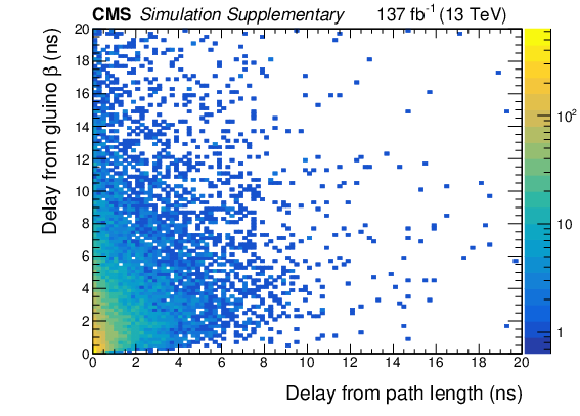
png pdf |
Additional Figure 23-a:
Jet delay contribution from the β of the gluino is plotted against the delay contribution from the difference (assuming straight line paths) between the path taken by the gluino and the particle forming the jet from the path length for a particle travelling directly to the same position on the ECAL barrel for gluino cτ0= 10 m and mass of 1000 GeV. The dominant contribution is shown to the gluino β. |

png pdf |
Additional Figure 23-b:
Jet delay contribution from the β of the gluino is plotted against the delay contribution from the difference (assuming straight line paths) between the path taken by the gluino and the particle forming the jet from the path length for a particle travelling directly to the same position on the ECAL barrel for gluino cτ0= 10 m and mass of 3000 GeV. The dominant contribution is shown to the gluino β. |
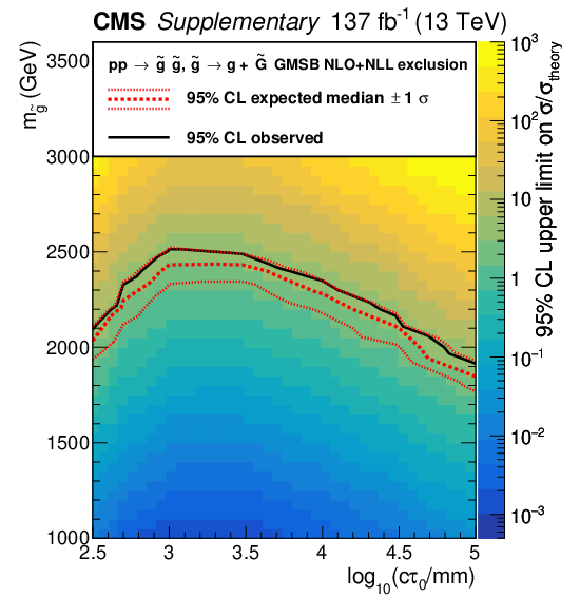
png pdf |
Additional Figure 24:
The 95% CL observed upper limits on σ/σtheory = 1 in the mass and cτ0 plane for the GMSB model after all selections for 137fb−1. The contour of 95% CL expected upper limits is shown in the solid line while the plus and minus one sigma variations are shown in the dashed lines. The observed limit is shown in the solid black line. |
| Additional Tables | |

png pdf |
Additional Table 1:
Selection efficiencies for the GMSB model with gluino mass 1000 GeV. |

png pdf |
Additional Table 2:
Selection efficiencies for the GMSB model with gluino mass 2400 GeV. |

png pdf |
Additional Table 3:
Selection efficiencies for the GMSB model with gluino mass 3000 GeV. |
| References | ||||
| 1 | N. Arkani-Hamed and S. Dimopoulos | Supersymmetric unification without low energy supersymmetry and signatures for fine-tuning at the LHC | JHEP 06 (2005) 073 | hep-th/0405159 |
| 2 | G. F. Giudice and A. Romanino | Split supersymmetry | NPB 699 (2004) 65 | hep-ph/0406088 |
| 3 | Z. Liu and B. Tweedie | The Fate of Long-Lived Superparticles with Hadronic Decays after LHC Run 1 | JHEP 06 (2015) 042 | 1503.05923 |
| 4 | J. Fan, M. Reece, and J. T. Ruderman | Stealth Supersymmetry | JHEP 11 (2011) 012 | 1105.5135 |
| 5 | M. J. Strassler and K. M. Zurek | Echoes of a hidden valley at hadron colliders | Physics Letters B 651 (2007), no. 5, 374 | |
| 6 | CMS Collaboration | Search for stopped gluinos in pp collisions at √s= 7 TeV | PRL 106 (2011) 011801 | CMS-EXO-10-003 1011.5861 |
| 7 | CMS Collaboration | Search for heavy stable charged particles in pp collisions at √s= 7 TeV | JHEP 03 (2011) 024 | CMS-EXO-10-011 1101.1645 |
| 8 | ATLAS Collaboration | Search for stable hadronising squarks and gluinos with the ATLAS experiment at the LHC | PLB 701 (2011) 1 | 1103.1984 |
| 9 | ATLAS Collaboration | Search for decays of stopped, long-lived particles from 7 TeV pp collisions with the ATLAS detector | EPJC 72 (2012) 1965 | 1201.5595 |
| 10 | CMS Collaboration | Search for heavy long-lived charged particles in pp collisions at √s= 7 TeV | PLB 713 (2012) 408 | CMS-EXO-11-022 1205.0272 |
| 11 | ATLAS Collaboration | Search for long-lived stopped R-hadrons decaying out-of-time with pp collisions using the ATLAS detector | PRD 88 (2013) 112003 | 1310.6584 |
| 12 | CMS Collaboration | Search for decays of stopped long-lived particles produced in proton-proton collisions at √s= 8 TeV | EPJC 75 (2015) 151 | CMS-EXO-12-036 1501.05603 |
| 13 | ATLAS Collaboration | Search for massive, long-lived particles using multitrack displaced vertices or displaced lepton pairs in pp collisions at √s= 8 TeV with the ATLAS detector | PRD 92 (2015) 072004 | 1504.05162 |
| 14 | ATLAS Collaboration | Search for metastable heavy charged particles with large ionization energy loss in pp collisions at √s= 13 TeV using the ATLAS experiment | PRD 93 (2016) 112015 | 1604.04520 |
| 15 | CMS Collaboration | Search for long-lived charged particles in proton-proton collisions at √s= 13 TeV | PRD 94 (2016) 112004 | CMS-EXO-15-010 1609.08382 |
| 16 | ATLAS Collaboration | Search for long-lived, massive particles in events with displaced vertices and missing transverse momentum in √s= 13 TeV pp collisions with the ATLAS detector | PRD97 (2018) 052012 | 1710.04901 |
| 17 | CMS Collaboration | Search for decays of stopped exotic long-lived particles produced in proton-proton collisions at 13 TeV | Journal of High Energy Physics 2018 (May, 2018) 127 | |
| 18 | ATLAS Collaboration | Search for long-lived neutral particles in pp collisions at √s= 13 TeV that decay into displaced hadronic jets in the ATLAS calorimeter | 1902.03094 | |
| 19 | CMS Collaboration | Search for long-lived particles in events with photons and missing energy in proton-proton collisions at √s= 7 tev | Physics Letters B 722 (2013) 273 | |
| 20 | ATLAS Collaboration | Search for nonpointing and delayed photons in the diphoton and missing transverse momentum final state in 8 TeV pp collisions at the LHC using the ATLAS detector | PRD90 (2014), no. 11, 112005 | 1409.5542 |
| 21 | J. Liu, Z. Liu, and L.-T. Wang | Long-lived particles at the LHC: catching them in time | 1805.05957 | |
| 22 | CMS Collaboration | The CMS experiment at the CERN LHC | JINST 3 (2008) S08004 | CMS-00-001 |
| 23 | CMS Collaboration | The CMS electromagnetic calorimeter project: Technical Design Report | CDS | |
| 24 | D. del Re | Timing performance of the CMS ECAL and prospects for the future | Journal of Physics: Conference Series 587 (2015), no. 1, 012003 | |
| 25 | CMS Collaboration | The CMS trigger system | JINST 12 (2017) P01020 | CMS-TRG-12-001 1609.02366 |
| 26 | M. Cacciari, G. P. Salam, and G. Soyez | The Anti-k(t) jet clustering algorithm | JHEP 0804 (2008) 063 | 0802.1189 |
| 27 | M. Cacciari, G. P. Salam, and G. Soyez | FastJet User Manual | EPJC72 (2012) 1896 | 1111.6097 |
| 28 | CMS Collaboration | Particle-flow reconstruction and global event description with the CMS detector | JINST 12 (2017) P10003 | CMS-PRF-14-001 1706.04965 |
| 29 | CMS Collaboration | CMS Luminosity Measurements for the 2016 Data Taking Period | CMS-PAS-LUM-17-001 | CMS-PAS-LUM-17-001 |
| 30 | CMS Collaboration | CMS luminosity measurement for the 2017 data-taking period at √s= 13 TeV | CMS-PAS-LUM-17-004 | CMS-PAS-LUM-17-004 |
| 31 | CMS Collaboration | CMS luminosity measurement for the 2018 data-taking period at √s= 13 TeV | CMS-PAS-LUM-18-002, CERN, Geneva | CMS-PAS-LUM-18-002 |
| 32 | T. Sjostrand, S. Mrenna, and P. Z. Skands | A Brief Introduction to PYTHIA 8.1 | CPC 178 (2008) 852--867 | 0710.3820 |
| 33 | NNPDF Collaboration | Parton distributions for the LHC Run II | JHEP 04 (2015) 040 | 1410.8849 |
| 34 | M. Fairbairn et al. | Stable massive particles at colliders | PR 438 (2007) 1 | hep-ph/0611040 |
| 35 | A. C. Kraan | Interactions of heavy stable hadronizing particles | EPJC 37 (2004) 91 | hep-ex/0404001 |
| 36 | CMS Collaboration | Extraction and validation of a new set of CMS PYTHIA8 tunes from underlying-event measurements | CMS-PAS-GEN-17-001 | CMS-PAS-GEN-17-001 |
| 37 | J. Alwall et al. | The automated computation of tree-level and next-to-leading order differential cross sections, and their matching to parton shower simulations | JHEP 07 (2014) 079 | 1405.0301 |
| 38 | GEANT4 Collaboration | GEANT4---a simulation toolkit | Nucl. Instr. Meth. A 506 (2003) 250 | |
| 39 | R. Mackeprang and D. A. Milstead | An updated description of heavy-hadron interactions in geant-4 | The European Physical Journal C 66 (Apr, 2010) 493 | |
| 40 | ATLAS Collaboration and CMS Collaboration | Procedure for the LHC Higgs boson search combination in Summer 2011 | CMS-NOTE-2011-005 | |
| 41 | T. Junk | Confidence level computation for combining searches with small statistics | Nucl. Instr. Meth. A 434 (1999) 435 | hep-ex/9902006 |
| 42 | A. L. Read | Presentation of search results: the CLs technique | JPG 28 (2002) 2693 | |
| 43 | CMS Collaboration | Search for long-lived particles with displaced vertices in multijet events in proton-proton collisions at √s= 13 TeV | PRD98 (2018) 092011 | CMS-EXO-17-018 1808.03078 |
| 44 | CMS Collaboration | Search for long-lived particles decaying into displaced jets in proton-proton collisions at √s= 13 TeV | Submitted to: PR(2018) | CMS-EXO-18-007 1811.07991 |

|
Compact Muon Solenoid LHC, CERN |

|

|

|

|

|

|